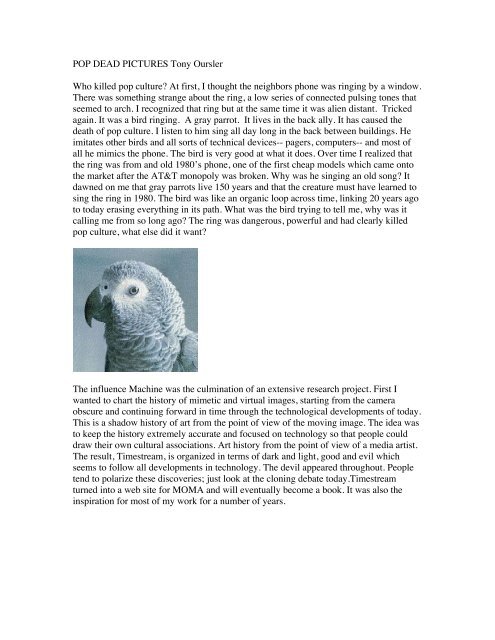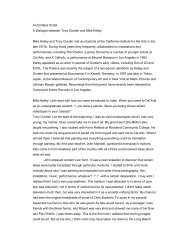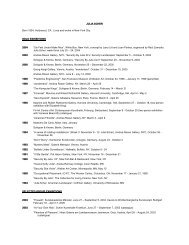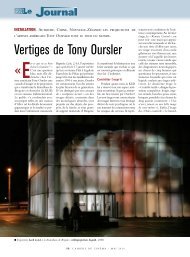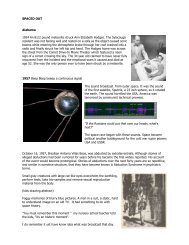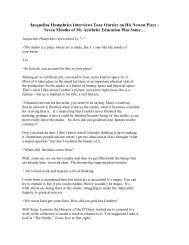Pop Dead Pictures (pdf) - Tony Oursler
Pop Dead Pictures (pdf) - Tony Oursler
Pop Dead Pictures (pdf) - Tony Oursler
Create successful ePaper yourself
Turn your PDF publications into a flip-book with our unique Google optimized e-Paper software.
POP DEAD PICTURES <strong>Tony</strong> <strong>Oursler</strong><br />
Who killed pop culture? At first, I thought the neighbors phone was ringing by a window.<br />
There was something strange about the ring, a low series of connected pulsing tones that<br />
seemed to arch. I recognized that ring but at the same time it was alien distant. Tricked<br />
again. It was a bird ringing. A gray parrot. It lives in the back ally. It has caused the<br />
death of pop culture. I listen to him sing all day long in the back between buildings. He<br />
imitates other birds and all sorts of technical devices-- pagers, computers-- and most of<br />
all he mimics the phone. The bird is very good at what it does. Over time I realized that<br />
the ring was from and old 1980’s phone, one of the first cheap models which came onto<br />
the market after the AT&T monopoly was broken. Why was he singing an old song? It<br />
dawned on me that gray parrots live 150 years and that the creature must have learned to<br />
sing the ring in 1980. The bird was like an organic loop across time, linking 20 years ago<br />
to today erasing everything in its path. What was the bird trying to tell me, why was it<br />
calling me from so long ago? The ring was dangerous, powerful and had clearly killed<br />
pop culture, what else did it want?<br />
The influence Machine was the culmination of an extensive research project. First I<br />
wanted to chart the history of mimetic and virtual images, starting from the camera<br />
obscure and continuing forward in time through the technological developments of today.<br />
This is a shadow history of art from the point of view of the moving image. The idea was<br />
to keep the history extremely accurate and focused on technology so that people could<br />
draw their own cultural associations. Art history from the point of view of a media artist.<br />
The result, Timestream, is organized in terms of dark and light, good and evil which<br />
seems to follow all developments in technology. The devil appeared throughout. People<br />
tend to polarize these discoveries; just look at the cloning debate today.Timestream<br />
turned into a web site for MOMA and will eventually become a book. It was also the<br />
inspiration for most of my work for a number of years.
The final project in Timestream was The Influence Machine. The work linked a trend in<br />
recent history of using technology to communicate with the dead, starting with spirit<br />
photographs, then the telegraph, radio, television, computer and finally the internet. This<br />
became the subject of the work. In the installation, various characters from history were<br />
channeled and projected into smoke: Gaspar Robertson, founder of the phantasmagoria;<br />
Baird, inventor of the mechanical TV; Farnsworth, inventor of the electronic TV; and the<br />
adolescent Kate Fox who was able to communicate with a dead man through a<br />
mysterious knocking code. Knocking became a key concept in the work; a violent force,<br />
causing energy to move from one medium to the next, resulting in vibration, sound and<br />
communication with the other side.<br />
In subsequent works knocking has morphed into the idea of the transmission process:<br />
messages, images, ideas, objects must be sent someplace. The material must be encoded,<br />
transmitted, received and decoded in another place. But of course, this is impossible.<br />
Distorting media specters abound in the electromagnetic spectrum and everything gets<br />
mixed up, lost, trans-mutated, miscoded. Technology ghosts everything. We base much
of our world on this fragile means of exchanging information. Somehow communication<br />
occurs in spite of the obstacles.<br />
A ghost is a comic character, unless you have just had someone close to you die. Then<br />
you have a different understanding of ghosts. It’s not funny when your TV program’s<br />
interrupted by fuzzy, electric characters faintly bleeding into your channel. You are upset<br />
because they don’t belong here in this time and space. Ghosts superimpose themselves,<br />
steal our space and time. What’s the point? Are they stupid? Do they have something<br />
important to say to you? This is a good assumption. But they are hard to see and hear,<br />
otherwise they would not be ghosts, would they? If you watch and listen carefully you<br />
can start to make out some of the words and sounds. It may take some time and<br />
concentration before the understanding begins.You must record the information, play it<br />
back repeatedly before the massage is revealed. Record. Play- back. Uncanny.<br />
Superstition? Primitive interpretation of physics? Does the signal emanate from<br />
another dimension, just another place? If you had the right equipment or antenna you<br />
could pick up the signal clearly and understand that it’s just some guy dispatching taxis in<br />
another language over some outdated radio system which is interfering with your TV set.<br />
No ghost! What if it’s a long dead actor in an old black and white movie? Sometimes all<br />
those actors are dead--moving around on the screen. Maybe it’s a military emergency<br />
signal sharing our bandwidth. Or a pirate broadcast unable to transmit very powerfully.<br />
Or someone’s good idea gone astray reaching you in a degraded form. Maybe some<br />
signals are parasites.<br />
Antennas are ugly. All the connections form a disturbing web-- roads, electricity,<br />
telephones, cables. They cut and claw the horizon into lines and spikes that I have come<br />
to appreciate. TV antenna, dishes, cell nodes and towers, this hardware reveals the true<br />
ugly nature of the system it supports in beautiful ways. The movement of waves is made<br />
evident in structure of antennas. They reach for something beyond their dull existence:<br />
signals. For example the untethered internet, operating at the unlicensed junk frequency,<br />
2.4 gigahertz called Wi-Fi. Wireless implies freedom, the citizen is connected to the<br />
world by antenna but is isolated, mobile.
Signals are full of potential as they float in the air before they are received. I was trying<br />
to capture this floating moment. What ephemeral substance would become a lens to make<br />
visible the invisible? It became a material question. After lots of searching I arrived at<br />
transparent fluorescent plexiglass shaped into disks, sawteeth and waves to hold the video<br />
projections, as well as to let them spill onto the walls and ceiling. The effect was faux<br />
holographic, like the screens you see in sci-fi movies, transparent and hanging in mid air.<br />
Later I discovered a metal screen material.<br />
The Antennas needed faces but they had to be wandering in their own atmosphere, lost in<br />
the ether, unstable. Moving lights were used while shooting to emphasize the shape and<br />
dimensions of the faces, like the way a person looks in a car driving at night. The faces<br />
are constantly being formed visually, chiaroscuro in waves of light. Then I needed the<br />
faces to move in a mechanical slide or loop, like a TV rolling. This was done with<br />
computer animation; they bend and distort as they travel over the surface of the sculpture.<br />
There is a lot of power, tension in the juxtaposition of the three kinds of movement<br />
human, light and mechanical.<br />
These heads are flying through space in a trance state. Language emanates from them.<br />
Words orbit them, like space junk. What they say is inspired in part by technical jargon,<br />
manuals, text books on satellite, radar, TV transmission, reception. The words take on<br />
new meaning out of context, sexualized, personified, equations for interpersonal power,<br />
interorized revelations. They sound like a machine trying to fix itself, maybe fix you at<br />
the same time. That's the way the heads are talking, verbally downloading their own<br />
personal instruction manual. It’s very intimate: E L F extremely low frequency avoid<br />
telephone get inside home stay away from open water avoid areas projecting above<br />
landscape go to low place valley isolated feel your hair stand on end drop off internet<br />
capture signals trap transmission avoid contact with the ground spherics: atmospheric<br />
interference admittance coordinator i get tired i get normalized lines candy candy candy<br />
constant resistance circles gray zone where? pulse under various conditions oh I see<br />
people walking up and down the street come on hurry up Doppler shift shadows listen to<br />
shadows ...<br />
These works were high up in the gallery installation, countered by works-- the blobs or<br />
pods-- which are down low, on the floor. These pod heads covered in glass slime or<br />
ectoplasm, like embryonic sacks. They are earthbound and a little sad about it. They wish<br />
they were able to wander the sky, disembodied but that's not their lot in life. They are in<br />
their own worlds, insulated, looking out, babbling to themselves, waiting. But there is<br />
something glowing inside them-- rays of light flow away from them, like they have<br />
developed special powers through isolation. I particularly like the glowing effect which<br />
was achieved by working with blown glass and projecting through it. There is a point just<br />
on the edge where some very interesting optical effects, refraction takes place. After a<br />
long research project on optics, it felt like the physics of it had slipped into the work.
Technology embodies Science and Fiction literally. What seems like pure science is,in<br />
fact, steeped in fiction--the ghost in the machine. I wanted to go inside the machine for<br />
the next projects which involved computer circuit boards, cylindrical plexiglass forms<br />
and wire block antennas. Very cyberspace... I fell in love with computer boards, acid<br />
green, silver solder, patterns snaking through their systems are over overwhelmingly<br />
beautiful. The computer, motherboard, opened up and animated is like the old computer<br />
game Pong: heads bounce around inside an imaginary space box.<br />
Bregenz Austria is a small border town on a large lake in the mountains adjacent to<br />
Germany and Switzerland. Here I was asked to produce a large scale work for the outside<br />
of the Kunsthaus building. The landscape with all the borders and broadcast towers,<br />
mountains sloping into a vast lake inspired me. It seemed to be the physical embodiment<br />
of the politics of borders, public space: the passage of images, ideas, cultures, and<br />
information from one medium to the next, one zone to another -- a place where one could<br />
easily escape. I used the outside of the building which faces the lake as a screen, as it was<br />
naturally divided into a grid of frosted glass blocks or pixels on a large scale. We used<br />
four projectors on scaffolding to cover the building with video. While preparing the<br />
video, I continued to use moving lighting on the performers faces, pushing for an extreme<br />
high contrast metal-ice blue to fuse with the cold glass surface of the building. The video<br />
was a computer-animated sliding puzzle of faces which slipped in one of four directions<br />
on the grid. The four video elements combined randomly as did the text. As with a<br />
border there is always someone coming or going invading or retreating, escaping into<br />
something new, a great open space of potential. We used six foot long trumpet-like<br />
speakers on the top of the building to project the sound towards the promenade along the<br />
lakefront. The speakers had been used by the <strong>Pop</strong>e on his visit to Austria and could<br />
direct and throw the sound very far.<br />
I used to live two blocks from the tallest TV broadcasting tower on the east coast, the<br />
World Trade Center. On September 11, we awoke to an explosion, that shook our bed --<br />
the sound of the first jet striking the north tower. I could see the gapping hole in the<br />
building, flames, bellowing smoke spotted with floating white papers in the sky through<br />
my skylight. Immediately I grabbed my video camera, went to the roof and started
shooting the horrors that unfolded on that blue, crystal clear morning. Smoke and flames<br />
poured from the gaping inferno. Jacqueline Humphries and I descended to the street and<br />
went closer to the towers, the street was a mix of people roboticlly on their way to work<br />
and people in shock. From a closer vantage, what seemed like debris falling from the<br />
building was actually people leaping to their death. This was one of the many moments<br />
when I had to turn off my camera that day for a variety of reasons: horror, fear, shock,<br />
and death. I couldn’t even focus my eyes on the tiny falling bodies, or process the event<br />
which was just beginning.<br />
I kept shooting video for the next weeks and months documenting the traumatized city’s<br />
spontaneous memorials, the Bosch-like remains of the tower and the strange<br />
transformation of my neighborhood and city. We collected detritus from our roofs, bits of<br />
building, paper and jet. I kept shooting photos and video because there was little else for<br />
me to do, everything stopped here at ground zero. I had no land phone or internet for six<br />
months. Everyone has deep feelings about what happened, political and personal. My<br />
reaction was to counter the material which was being filtered by the major media and<br />
document what was happening around me. I would make a documentary by piecing<br />
together bits of my footage, TV and friends’ video to fill in the parts I missed,<br />
importantly a shot from Brooklyn of the collapse of the towers by John Kelsey.<br />
I shot a number of ambient videos of the pit in various stages of demolition. But the<br />
street life near Ground Zero was what really fascinated me as it transformed into an<br />
instant tourist site and memorial populated by visitors from all over the world. I used to<br />
go over in the middle of the night and once I saw the saddest thing I ever experienced: a<br />
woman was screaming and crying out a name into the darkness of the pit .All kinds of<br />
religious characters arrived to preach and give solace, pamphlets were printed and<br />
distributed and ramshackle perimeters were erected and altered daily. But almost<br />
everyone who made the gruesome pilgrimage wanted to do one thing: take a picture with<br />
their camera. I started shooting the people shooting ground zero, studying the way they<br />
related to their cameras their screens. People are selling horrific snapshots of the event,<br />
and one series of images are marked, “devils head”. The peddler explained, “ if you look<br />
closely you can see the face of the devil in the red-orange fire ball “.
John Edwards performs cold readings on his popular TV show, “Crossing Over.” He is<br />
the latest in the long tradition of those who claim to communicate with the dead and have<br />
visions. People go on his show to find a way to communicate with their lost loved ones.<br />
As he cold reads the audience, he becomes a sort of machine of percentages: “you lost<br />
someone older, an aunt or uncle, I see very white hair”. He has a great understanding of<br />
the averages, and has at least a 50/50 chance of being right. He knows what we want is<br />
universal and the more universal his statements, the more correct he will be; thus more<br />
psychic. The more universal, the more profound and boring. As seen on TV, when the<br />
paranormal is real it’s about the simple details of life. We need the medium to tell us: the<br />
dead have all the same problems as the living.<br />
What is interesting to me is the way spiritualism has changed from an evidence based<br />
operation to a faith based operation, from a visual cultural to a culture of language or<br />
pure message: verbal possession, channeling or multiple personality of the dead. The<br />
visual evidence of the past, the spirit photographs, the video feedback of Timestream (the<br />
spirit TV station of the 1980’s) are replaced by spoken word spirits. Who can argue with<br />
I guy who says he sees the dead, that they talk through him? There is no tangible<br />
evidence to judge his claims. His voice is beyond proof. It is remarkable that in an age of<br />
amazing special effects which depict all kinds of fantasy spaces, the most convincing<br />
connection to the spirit world is simply a guy talking on TV.
“Hot ear” is the major complaint about cell phones, yet no one knows if the phones give<br />
you cancer. Urban myth warns that if you talk on a cell phone while pumping gas, your<br />
car will explode. Exposing rats to RF radiation at an average whole-body exposure of 1<br />
W/kg of body weight caused breaks in the DNA of their brain cells. When testing for RF<br />
exposure, a computer model or a tank of liquid in the shape of a head is used. Cell phones<br />
in the United States operate between 850 MHz and 1900MHz. If we look at the sky we<br />
see it as a blank blue slate but at the same time we know all the information in the world<br />
is up there in the heavens. It’s full of the spectrum. The delegation of frequencies is a<br />
cultural organizer from 3KHz to 3000Ghz: Citizen Band Radio, Timesignals, Radio and<br />
Television Broadcasting, Wildlife tracking collars, Satellite, Radio Astronomy, Space<br />
Research, Earth Exploration. So much information moves from one station to the next,<br />
through rocks, trees and buildings. We are antennas, all that stuff moves through us.<br />
Different parts of our body, organs, bones conduct differently and can be measured. Here<br />
is a model of the average human bodies as an antenna for ELF (extremely low<br />
frequency):
I started out as a painter when I was a boy. Painting is a base from which I work. I had a<br />
number of crises in relation to images. I believe that if an image exists, then it has already<br />
destroyed the possibility of being constructed by the viewer. I’m like the guy who goes to<br />
church because he likes the smell of incense. I'm lost but I'm looking for the magic. I'll<br />
try a little harder because I’m happily lost. It’s all about faith otherwise forget it, there are<br />
too many images out there.The drawings are linked to my research in recent years. I’m a<br />
manic collector of images, they inform all my installation work. They also act as an<br />
abstract diary for me. There is a tension between my graphic work and my installation<br />
work, they come from two different parts of the brain. I play with the the 2-D work while<br />
I make it, use it as a way of meditating into material that fascinates me. That’s how I<br />
think about images. Good ones are to be dreamed into, they don’t tell you what to dream.<br />
Recently I’ve been reading psychology studies on the formation of mental images that<br />
fall into two categories. 1) Visual Trace: images which have been directly observed and<br />
committed to short term memory by the viewer (VT). 2) Generated Images: mental<br />
images constructed by the viewer from verbal instruction. Visual Trace comes form low<br />
level processes, directly from perception and Generated Images result from higher level<br />
processes including the comprehension of instructions. Tests concluded that some more<br />
complicated unstable images can be better committed to memory through GI then<br />
through VT. This separation of image construction is somehow at the core of my work. I<br />
want you to self-construct while Generating Image. Not self destruct.<br />
That's the problem here and now with images at the end of pop culture: they mean<br />
everything and nothing. See dead pop-pictures everywhere morphing as one big<br />
nonspecific drug-like mass. When everything is moving and nothing reflects us in the<br />
mediastream an argument can be made that now is the best time for a still image.<br />
Hollywood, TV, advertising all work on you not with you. This is what separates art from<br />
pop culture. This is why art is alive and pop is dead. Statistically more and more people<br />
are going to museums. People respond to art because they find a space which has<br />
vanished in pop culture, a place which is unique because it respects and acknowledges<br />
them, and seeks to engage them in dialogue.
Sleepwalk is the title of a collaborative installation which artist Jacqueline Humphries<br />
and I exhibited at the beginning of 2002. Jacqueline is a painter who uses abstraction to<br />
explore issues of contemporary screen space among other things. We are both fascinated<br />
by transportation space; where the traveler moves at the center of their own perspective<br />
which is in turn punctuated by the flow of architecture, advertising and cinematic space.<br />
It seemed like a good frame work for us to collaborate within as humphries has used<br />
these elements in her work for years. We designed a fanciful landscape filled with simple<br />
set-like wood and plaster constructions: hand-held placards, highway billboards, street<br />
signs and movie screens. Each of these spaces was blanked out and then reassigned a new<br />
purpose with video projections. As people wander through this semiotic dream space they<br />
are invited to carry one of the blank signs and catch parts of the projections to participate.<br />
A movie screen becomes a distant gulf coast electric storm, a road construction sign,<br />
anchored with sand bags is endlessly slathered with something scatological brown,<br />
chocolate frosting? An acid green, infrared shot of a smoke bellowing factory locates this<br />
landscape someplace in the industrial southeast of the USA. There is the rural existential<br />
symbol, the blank billboard, waiting to be occupied. Other screens are new developments<br />
in Humphries work: video paintings. These are large scale projections which blow-up the<br />
fluid process of painting. The colorful liquid screen “Miasma,” becomes a fractal-like<br />
toxic delta satellite image. A macro shot of a painting brush becomes six feet wide when<br />
projected, it’s bristles as thick as fingers raking endlessly through the paint. Each stroke<br />
of the brush slightly alters the colors like waves lapping at some alien shore. Even<br />
though parts of the installation contain sunshine of course the whole thing was meant to<br />
take place in a somnabulist state of mind at night.<br />
Sunlight and video are a delicate mix. I really got the bug for working outside in public,<br />
it’s a natural extension of the use of found objects and liminal indoor space. But the light<br />
barrier has always bothered me technically and theoretically. Of course, there is an<br />
association with video installation art and dark spaces, black walls. I have worked in<br />
those dark rooms and used this as part of the subject of my installations but mostly I<br />
prefer more lighted spaces,. However, projectors in the past have been so weak that it<br />
became necessary to work in a mostly dark cinematic rooms.
Sadly, video art was set up in opposition to the more traditional world of art which is<br />
locked into “neutral” white walls as a tradition. But if you look carefully at this tradition<br />
it soon falls apart. White walls and even lighting is a very recent and arguably artificial<br />
development. For example, some impressionists preferred colored walls and not so long<br />
ago the organic fluctuations of sun light and gas light were the norm. Is an art work<br />
diminished when installed in a domestic setting? Once one starts to think about the<br />
complications of the perfect neutral space the details never end; electric light is in no way<br />
neutral unless expensive full spectrum bulbs are used; at what brightness; what is the<br />
most neutral white paint? There is no end to it and in fact there is no such thing as an<br />
ideal art space: it’s a cultural construct of the moment.<br />
The outdoors is an attractive place for art to be installed. There one finds a different<br />
audience and a very un-neutral, highly charged setting. Television is a very powerful<br />
light source and can almost stand up to direct sun light so I used one in Guard Booth, my<br />
first permanent outdoor installation in Korea. But I wanted to use other light sources and<br />
designed a laser system, and then an LED system though they were to difficult to<br />
produce. Recently projectors have become much brighter but they still can’t project in<br />
direct daylight at the same scale they are designed to display inside. I decided to play a<br />
little inversion game with them: to use a relatively large projector and project it on a<br />
rather small surface and see how it worked outside. This experiment coincided with the<br />
opportunity to produce an outdoor work in Bad Driberg and the result was Shock Rock.
When I visited the spa and looked around I was taken by the history of the place which<br />
dated from the mid 1700’s. Of course the implications of the history of technological<br />
body/electricity was fascinating for me; as many of the most interesting developments on<br />
my time line were surely used in this spa at one time or an other. But the one architectural<br />
feature which struck me was the wonderful, classical band shell, set in the trees. It is a<br />
physical embodiment of entertainment, more in the shape of a horn than a stage. In a very<br />
quaint setting one can see the roots of the development of media culture, the fluted shape<br />
of it’s walls intended to amplify the individual for the masses. This place felt like a<br />
vortex between different eras of popular music; constructed from the past, present and<br />
future. It has a lonely hearts feeling to it; a building designed to resonate, to focus the<br />
vibrations.<br />
The cadence of speech can have a musical quality and I wanted to explore that quality<br />
with this installation, extend it. A transformation of my scripts takes place when<br />
delivered by a performer in a musical way; not sung but in an interior sing-song voice in<br />
your head. Personal humming is a model for the kind of inside-out music I wanted to<br />
make for this work. I returned to the doubled self in the form of two large projected heads<br />
about three feet high, one vertical and one horizontal. I wanted a harmonizing and<br />
discord of two heads, of the exact same tones, the same inner voices. Let the voices eat<br />
themselves recreate themselves. I worked with Barbara Sukowa, a movie star, who is<br />
very well known in Germany. She has worked with Fassbender and Von Trier so I was<br />
delighted to have the chance to work with her. She was able to melt into the text, to have<br />
it become extremely personal and fragile and then suddenly violent and aggressive. Yet<br />
somehow the performance remains playful at it’s core, which for me is the essence of<br />
music: play.<br />
What’s dead serious is the fact that five or six companies own most of the cultural<br />
production in the world at the moment. Newscorp, Disney, Viacom, Universal Vivendi,<br />
AOL/Time Warner. It’s one big food chain with the big beasts swallowing up the small.<br />
Harvesting through sounds and pictures, kid culture, everything you see and hear is<br />
connected and for sale. <strong>Pop</strong> consumes itself and shits out money. The equation is<br />
roughly: pop song=universal+ transcendance+ media control= capitol trap= sell you<br />
back to you and sell you back to you and sell you back to you
where A is the vector potential vertically mounted surface perfectly conducting body<br />
wrestling remain positive, believe harmonics, power, shift, box, converter,<br />
stage? shell? Hey this is the vox pop you know elevated levels broadcast bursts<br />
under one wires three phase transmission line let go blockbuster dead?<br />
happy in the head? You’re not dead. Happy in the head? You’re not dead near a power<br />
line useful in fringe area you come back time and again consciousness channel surfer<br />
kaleidoscope insulated free space who wants to hear it?<br />
Within all information systems there is an undesirable build up of excess energy in the<br />
form of heat, light or interference which must be shunted, burned off, vented or otherwise<br />
dissipated before it threatens the functioning of that system. Interference may take the<br />
form of acoustic low-frequency noise (LFN), deep drone, fluorescent buzz, diesel engine<br />
idling, or distant rumbling. You can’t tell where it’s coming from; a factory or power<br />
station or microwave communications network someplace else. It can come from far<br />
away, through the ground of air. In Kokomo the hum has been described as the sound of<br />
“ butter crackling in a hot skillet.” People have complained that the hum is making them<br />
sick; they suffer from “ dizziness, nosebleeds, extreme fatigue, joint and muscle pain,<br />
and excruciating ,unending headaches.” There have been reports of ‘Taos Hum”, in New<br />
Mexico, “Larg Hum “ in Scotland, “Bristol Hum” in England. There are also Hums in<br />
Japan and Scandinavia. Only some people are able to hear The Hum and IGZAB, a<br />
German group who suffers from the problem believes the following two factors must be<br />
present: 1. a personal disposition; 2. an influence from the outside. Nearly all victims<br />
perceive the tone as so perfect that it has to be man-made. Affected people have the<br />
impression that “vibrations” or “electric current” move through the body toward the head<br />
and involve two modulating tones whistling noise. A Hum simulator is provided at<br />
www.brummt.de with the following Warning: “Please keep in mind that humming noises<br />
generated by this software possibly endanger your health. Playing this sound is on (sic)<br />
your own risk.”


